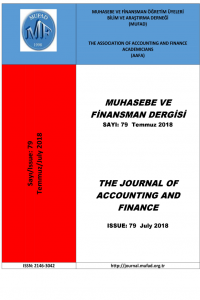Öz
Dünyada pek çok ülkede var olan işletme gruplarının oluşum ve yaygınlık nedenleri pek çok akademisyenin ilgisini çekmiştir. İşletme gruplarının oluşumunda temel nedenler piyasa kusurları ve bilgi sorunlarını önlemek, piyasa belirsizliklerini azaltmak ve riski çeşitlendirmek olarak sıralanabilir. Bu çalışma, Türkiye’deki firmaların sermaye yapısı seçimlerinin bir işletme grubuna bağlılık nedeni ile farklılaşıp farklılaşmadığını incelemektedir. Çalışmada Borsa İstanbul’da işlem gören, finansal sektör dışındaki 68 adet şirketin 2008-2016 yılları arasındaki dönemini kapsayan ve toplamda 612 gözlemin yer aldığı dengeli bir panel veri seti ile çalışılmıştır. Araştırma yöntemi olarak dinamik panel veri analizi yöntemi kullanılmıştır. Genelleştirilmiş momentler yöntemi (GMM) ile tahmin edilen modeldeki sermaye yapısını açıklayıcı değişkenler sermaye yapısı ile ilgili üç önemli teori baz alınarak kullanılmıştır. Bunlar, dengeleme teorisi, gagalama sıralaması teorisi ve temsil maliyetleri teorisidir. Çalışmanın başlıca bulgusu işletme grubuna bağlı şirketlerin bağımsız firmalara göre daha fazla kaldıraca sahip olduğudur. Bu bulgu da işletme grupları ve içsel sermaye piyasaları ile ilgili teorileri destekler niteliktedir.
Anahtar Kelimeler
İşletme grupları sermaye yapısı sahiplik yapısı panel data içsel sermaye piyasaları
Kaynakça
- Anderson, R.C. - Mansi, S.A. - Reeb, D.M. (2003), “Founding family ownership and the agency cost of debt”, Journal of Financial Economics, Vol.68, issue.2, pp: 263-285
- Arellano, M. - Bond, S.,(1991), “Some tests of specifications for panel data: Monte Carlo evidence and an application to employment equations”, Review of Economic Studies, Vol.58, pp:277-297.
- Boyle, G.W. - Eckhold, K.R (1997), “Capital structure choice and financial market liberalization: evidence from New Zealand”, Applied Financial Economics, Volume 7,Issue 4, pp:427-437
- Faccio, M, - Lang, L.(2002), “The ultimate ownership of western European corporations”, Journal of Financial Economics,Vol.65, pp: 365-395.
- Fama, E. - Jensen, M.C.(1983), “Separation of ownership and control”, .Journal of Law and Economics, Vol.26,pp: 301-325.
- Feenstra, R.C. - Huang, D.S ve Hamilton, G.G. (2003), “A market power based model of business groups”, Journal of Economic Behavior and Organization, Vol. 51,pp: 459-485
- Galai, D. - Masulis, R.(1976), “The option pricing model and the risk factor of stock”, Journal of Financial Economics, Vol. 3, issue 1-2,pp: 53-81
- Gertner, R.H.,Scharfstein, ve D.S, Stein, C.S. (1994), “Internal versus external capital markets”, NBER Working Paper Series, Working Paper No.4776
- Gonenc, H.- Kan, O. - Karadagli, H. (2007), “Business groups and internal capital markets”, Emerging Markets Finance and Trade, Vol.43, No.2, pp: 63-81
- Gonenc, H.- Kan, O. - Karadagli (2004), “Corporate diversification and internal capital markets: Evidence from the Turkish Business Groups”, Basel Meetings paper, EFMA 2004, https://papers.ssrn.com/sol3/papers.cfm?abstract_id=500163
- Gronovetter, M. (1995), “Coase revisited: Business groups in the modern Economy”, Industrial and Corporate Change, Vol.4, Issue.1, pp:93-130, https://doi.org/10.1093/icc/4.1.93
- Guillén M.F. (2000), “Business groups in emerging economies: a resource based view”, Academy of Management Journal, Vol.43, pp: 362-380
- Hsiao, C.(1985), “Benefits and limitations of panel data”, Economic Review, Vol.46, issue.4, pp:1251–1271
- Hoshi, T. - Kashyap, A. - Scharfstein, D. (1990), “The role of banks in reducing the costs of financial distress in Japan”,Journal of Financial Economics, Vol.27, issue.1,pp: 67-88
- Jensen, M. - Meckling, W. (1976), “Theory of the firm: managerial behaviour, agency costs and capital structure”, Journal of Financial Economics, Vol.3,pp: 305-360
- Jensen M. (1986), “Agency costs of free cash flow, corporate finance, and takeovers”, American Economic Review, Vol. 76, No. 2,pp. 323-329
- Khanna T. - Palepu K. (2000), “The future of business groups in emerging markets: Long – run evidence from Chile”, Academy of Management Journal, Vol., pp: 268-285.
- Khanna T, Rivkin J W. (2001), “Estimating the performance effects of business groups in emerging markets”, Strategic Management Journal, Vol.22, pp: 45-74,
- Khanna, T. - Rivkin,J W. (2006), “Interorganizational ties and business groups boundaries: Evidence from an emerging economy”, Organization Science, Vol.17, Issue.3, pp:333-352
- Khanna T.(2000), “Business groups and social welfare in emerging markets: existing evidence and unanswered questions”, European Economic Review, Vol.44,pp: 748-761.
- Kraus, A. - Litzenberger, R. (1973), “A state-preference model of optimal financial leverage”, The Journal of Finance,Vol.28,No.4,pp.911-922
- Leff, N. (1978), “Industrial organization and entrepreneurship in the developing countries: The economic groups”, Economic Development and Cultural Change ,Vol.26, pp: 661-675
- Manos, R.- Murinde, V. - Green, C.J. (2007), “Leverage and business groups: evidence from Indian firms”, Journal of Economics and Business, Vol.59, pp: 443-465
- Myers, S.C. (1984), “The capital structure puzzle”, Journal of Finance, Vol.39, issue.3, pp:575-592
- Myers,S. - Majlup, F.(1984), “Corporate financing and investment decisions when firms have information that investors do not have”, Journal of Financial Economics, Vol. 13, pp:187-221
- Myers, S. (1977), “Determinants of corporate borrowing”, Journal of Financial Economics, Volume 5, Issue 2, pp: 147-175
- Prasad, S.- Green, C.J - Murinde, V. (2001), “Company financing, capital structure and ownership: A survey and implications for developing economies”, Loughborough University Economics Research Paper, http://dspace.lboro.ac.uk
- Rajan, R. - Zingales, L. (1995), “What do we know about capital structure? Some evidence from international data”, Journal of Finance, Vol. 50,pp: 1421-1460.
- Shleifer, A. - Vishny, R.W. (1986), “Large shareholders and corporate control”, Journal of Political Economy, Vol.94, issue.3, pp:461-488.
- Tatoğlu, Y.F. (2013), “İleri panel veri analizi”, Beta Yayınları, İstanbul
- Titman S. - Wessels R. (1988), “The determinants of capital structure choice”, Journal of Finance, Vol. 43, No. 1,pp. 1-19.
Ayrıntılar
| Birincil Dil | Türkçe |
|---|---|
| Konular | İşletme |
| Bölüm | Araştırma Makalesi |
| Yazarlar | |
| Yayımlanma Tarihi | 2 Temmuz 2018 |
| Gönderilme Tarihi | 8 Ocak 2018 |
| Yayımlandığı Sayı | Yıl 2018 Sayı: 79 |


